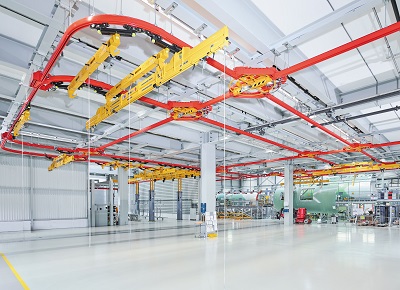
Members of the Crane Manu-facturers Association of America, Inc. (CMAA), the Hoist Manufacturers Institute (HMI) and the Monorail Manufacturers Association (MMA) have joined together to form The Overhead Alliance. Its purpose is to communicate the benefits of using overhead lifting solutions to move materials within manufacturing and wholesaling facilities. Installing these overhead lifting solutions improves the safe working environment while also improving efficiency, productivity and reducing environmental impact.
What makes overhead lifting safer?
Overhead cranes, hoists and monorails move suspended loads within a predefined work area, allowing the operator to be a safe distance from the load, explained Dustin Krauth, regional sales manager/marketing at MHI member TC/American Crane Company. “Since the load can be lifted up and over obstacles, it does not need to move along the same path as the facility’s pedestrian traffic,” he said. As a result, the operator remains safe while pedestrian traffic also proceeds safely because it does not have to share the space with floor-based equipment. With lifting equipment operating in a defined workspace, companies can safeguard workers and equipment within that area.
Using overhead equipment also provides the opportunity to automate lifting and transporting applications, set up protected “no travel” zones and include target positioning areas. Another benefit of overhead lifting solutions is that the operator can be socially distant from other workers, reducing the possible risk of spreading viruses.
By using overhead lifting solutions, both light and heavy loads can be lifted and moved more ergonomically, noted Laura Antenucci, marketing manager at MHI member Demag Cranes and Components Corp. “Overhead lifting can replace manual lifting,” she said. “When (ergonomically correct) manual lifting techniques are not followed properly or an awkward load is lifted improperly, injuries to workers can result.” Even when workers use correct lifting techniques, repetitive lifting of light loads can cause injury to workers over time. Using overhead lifting tools to replace human effort reduces that injury risk.
Custom made overhead lifting devices can be used to move loads of unusual shapes and sizes, added Henry Brozyna, industrial product trainer at MHI member Columbus McKinnon Corporation. This also cuts down the chance of injuries to personnel.
Overhead lifting equipment operators have another safety advantage compared to operators using floor traveling equipment. They can position themselves so they can see the load and its path without having to twist their bodies to look around the load.
 MHI Solutions Improving Supply Chain Performance
MHI Solutions Improving Supply Chain Performance